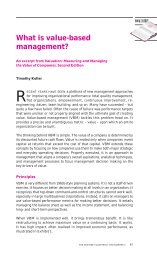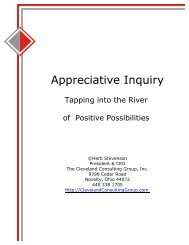Chapter I: Introduction to Data Mining
Chapter I: Introduction to Data Mining
Chapter I: Introduction to Data Mining
You also want an ePaper? Increase the reach of your titles
YUMPU automatically turns print PDFs into web optimized ePapers that Google loves.
© Osmar R. Zaïane, 1999 CMPUT690 Principles of Knowledge Discovery in <strong>Data</strong>bases<br />
• Medical and personal data: From government census <strong>to</strong> personnel and cus<strong>to</strong>mer<br />
files, very large collections of information are continuously gathered about<br />
individuals and groups. Governments, companies and organizations such as<br />
hospitals, are s<strong>to</strong>ckpiling very important quantities of personal data <strong>to</strong> help them<br />
manage human resources, better understand a market, or simply assist clientele.<br />
Regardless of the privacy issues this type of data often reveals, this information is<br />
collected, used and even shared. When correlated with other data this information<br />
can shed light on cus<strong>to</strong>mer behaviour and the like.<br />
• Surveillance video and pictures: With the amazing collapse of video camera<br />
prices, video cameras are becoming ubiqui<strong>to</strong>us. Video tapes from surveillance<br />
cameras are usually recycled and thus the content is lost. However, there is a<br />
tendency <strong>to</strong>day <strong>to</strong> s<strong>to</strong>re the tapes and even digitize them for future use and<br />
analysis.<br />
• Satellite sensing: There is a countless number of satellites around the globe:<br />
some are geo-stationary above a region, and some are orbiting around the Earth,<br />
but all are sending a non-s<strong>to</strong>p stream of data <strong>to</strong> the surface. NASA, which controls<br />
a large number of satellites, receives more data every second than what all NASA<br />
researchers and engineers can cope with. Many satellite pictures and data are<br />
made public as soon as they are received in the hopes that other researchers can<br />
analyze them.<br />
• Games: Our society is collecting a tremendous amount of data and statistics about<br />
games, players and athletes. From hockey scores, basketball passes and car-racing<br />
lapses, <strong>to</strong> swimming times, boxer’s pushes and chess positions, all the data are<br />
s<strong>to</strong>red. Commenta<strong>to</strong>rs and journalists are using this information for reporting, but<br />
trainers and athletes would want <strong>to</strong> exploit this data <strong>to</strong> improve performance and<br />
better understand opponents.<br />
• Digital media: The proliferation of cheap scanners, desk<strong>to</strong>p video cameras and<br />
digital cameras is one of the causes of the explosion in digital media reposi<strong>to</strong>ries.<br />
In addition, many radio stations, television channels and film studios are<br />
digitizing their audio and video collections <strong>to</strong> improve the management of their<br />
multimedia assets. Associations such as the NHL and the NBA have already<br />
started converting their huge game collection in<strong>to</strong> digital forms.<br />
• CAD and Software engineering data: There are a multitude of Computer<br />
Assisted Design (CAD) systems for architects <strong>to</strong> design buildings or engineers <strong>to</strong><br />
conceive system components or circuits. These systems are generating a<br />
tremendous amount of data. Moreover, software engineering is a source of<br />
considerable similar data with code, function libraries, objects, etc., which need<br />
powerful <strong>to</strong>ols for management and maintenance.<br />
• Virtual Worlds: There are many applications making use of three-dimensional<br />
virtual spaces. These spaces and the objects they contain are described with<br />
special languages such as VRML. Ideally, these virtual spaces are described in<br />
such a way that they can share objects and places. There is a remarkable amount<br />
of virtual reality object and space reposi<strong>to</strong>ries available. Management of these<br />
reposi<strong>to</strong>ries as well as content-based search and retrieval from these reposi<strong>to</strong>ries<br />
are still research issues, while the size of the collections continues <strong>to</strong> grow.<br />
University of Alberta page 2 Department of Computing Science
















